News & Events
NAFTRG Adds Wood Turtle Study Site
September 12, 2022
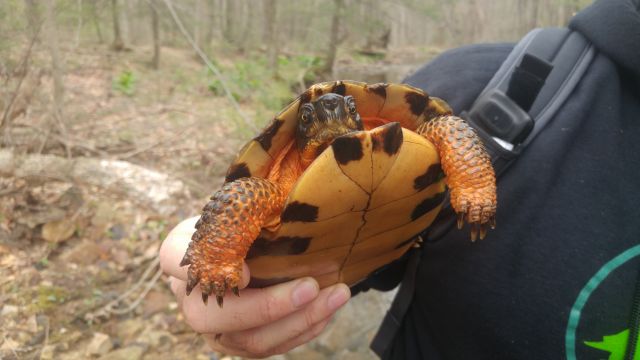
by Jordan Gray

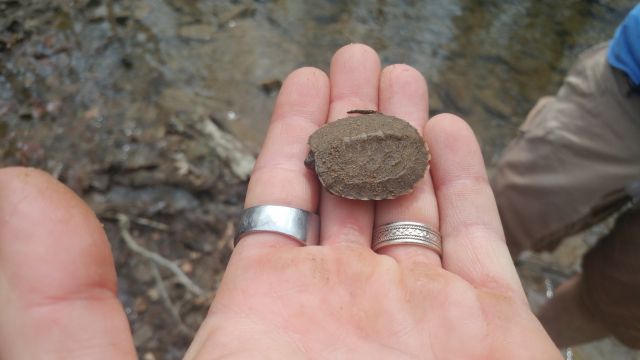
What do you get when you add a group of gung-ho turtle enthusiasts, hours of satellite reconnaissance, hundreds of emails, permit applications and cool montane streams? Wood turtles…and a gaggle of other chelonians to boot. Such was the goal when Eric Munscher, Director of the Turtle Survival Alliance’s North American Freshwater Turtle Research Group (NAFTRG) and Steve Enders, President of The Turtle Room, both Pennsylvanians, began their discussions of a future collaborative project last August in Tucson, Arizona.
Although native Pennsylvanians, Eric and Steve formally met a couple thousand miles away from their home state at the 13th Annual Symposium on the Conservation and Biology of Freshwater Turtles and Tortoises held at the La Paloma Resort and Spa in Tucson. It was at this aggregation of chelonian conservationists, hobbyists, researchers and general enthusiasts that the first discussions to create a new long-term monitoring site for Pennsylvania chelonians took place. Being a mutual friend of both, I, Jordan Gray, who has a long history working with North American wood turtles (Glyptemys insculpta) and other Emydids of the American Mid-Atlantic, was added into the discussion. Our group left Tucson with a goal of finding the perfect habitat in Southeast/South-central Pennsylvania to embark on the 13th long-term population-monitoring site for the NAFTRG, as well as adding some other chelonian experts into the fold.
In November of 2015, utilizing Google Earth, scientific literature, anecdotal accounts and cross-referencing with the Pennsylvania Natural Heritage Program (PNHP) the group, who had now added Arron Tuggle of the NAFTRG, began intensely searching for the right habitat features to fit the proposed project. The NAFTRG specializes in multi-species monitoring and so a habitat criterion was developed that would hypothetically yield multiple sympatric species of freshwater Pennsylvania Emydids. While the primary criterion was centered around the seasonal needs of the North American wood turtle, a species who spends significant amounts of time in the water and on land during the year, they also were designed to include the Eastern painted turtle (Chrysemys picta), snapping turtle (Chelydra serpentina), spotted turtle (Clemmys guttata), musk turtle (Sternotherus odoratus), red-eared slider (Trachemys scripta elegans), Northern map turtle (Graptemys geographica), Eastern spiny softshell (Apalone spinifera), and Midland smooth softshell (Apalone mutica). (Although the bog turtle Glyptemys muhlenbergii would most likely be of presence in some of the habitats associated with the species assemblage, due to their Federal Status, we decided to not include them due to permitting logistics.) To include the possibility of finding all of these species living in a sympatric association, sites that featured clear, meandering streams, vernal pools, marshes or swamps, the large open water bodies of ponds or lakes, and hardwood riparian corridors and upland habitat would be necessary.
By late December 2015, nine sites were proposed to the PA Fish and Boat Commission (PFBC), PNHP and Pennsylvania State Game Lands (SGL), of which three were immediately crossed off the list as there were current wood turtle surveys being performed there already. The remaining six were virtually unknown, scientifically speaking, as to the extent of the populations of the aforementioned species. While all of the sites looked promising from behind a computer screen, it was decided that the group, who had now added Joe Pignatelli of EcolSciences, Anthony Pierlioni of The Turtle Room, Jeff Popp of the Chesapeake Bay Trust, Dr. Josiah Townsend of the Indiana University of Pennsylvania, Andy Weber of the United States Parks Service, and with professional assistance from Dr. Michael Jones of the University of Massachussetts ‚Äì Amherst, should meet within the next several months, when the turtles become active again, to perform “boots-on-the-ground” site evaluations. After taking into account everyone’s work schedules, personal calendars, vernal progression, and species-based seasonal activity thresholds, it was decided that the weekend of April 21 ‚Äì 24 would be the only weekend during the Spring season in which the evaluations could take place.
This Spring was very unpredictable for the East Coast and the Mid-Atlantic in particular. With frequent warm spells, which began earlier than normal, combined with rapid drops in temperature and prolonged cold fronts, it made for predicting the upcoming activity of the chelonians more difficult than desired. By the time April had come around, vernal activity for many herpetological harbingers of Spring had already been well underway according to vouchered accounts of personal colleagues and the Pennsylvania Amphibian and Reptile Survey. To say the least, the recon team was building up anticipation for the upcoming evaluations, while also worrying that we may lose our best window for finding the proposed species living in temporal association.
The next morning, began with a rather cool, dark, overcast, slightly drizzling, 50-degree reminder that as much as you plan, you can’t control the weather. Luckily, we were dealing with some pretty hypothermic-tolerant turtles. We drove the half-hour from York, PA where we had stayed the night, across the Susquehanna River to Lititz, PA, to meet with Steve at his place. (Steve, by the way, has a really cool assortment of Graptemys species!) We then left to rendezvous with Anthony, who had driven all night from Connecticut to join us, that morning.
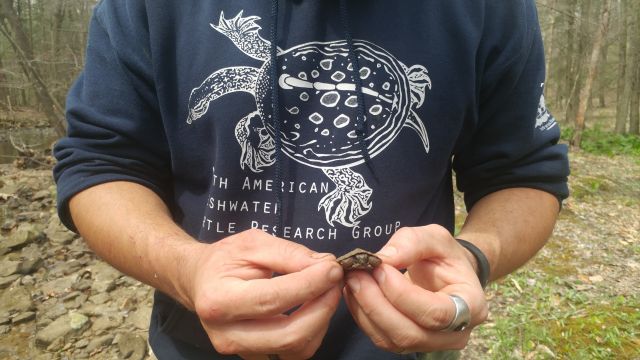
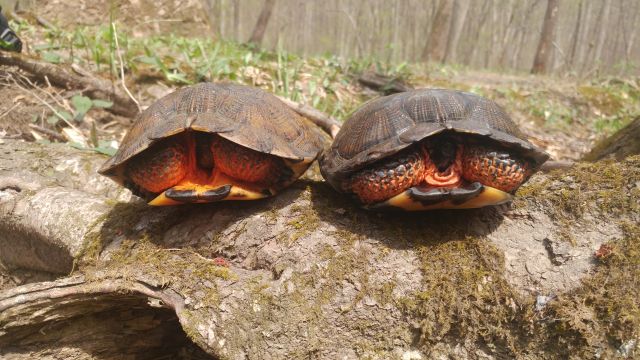
Our first site was located about an hour and a half north of Steve’s in Schuylkill County. Through our satellite imagery reconnaissance, we had high hopes for this site as it looked to offer all of the components we desired in a long-term site: Clear stream, vernal wetlands, two lakes, hardwood forest, and relatively easy access for future NAFTRG/TTR field researchers. Upon arrival, it didn’t have that “wow” effect on us that we had anticipated, primarily due to the fact that one of the lakes had a well-hardened shoreline, almost completely void of any natural lakeshore components and there were several houses whose backyards encompassed the stream that connected the two lakes. Although we knew going into it that there would be some degree of anthropogenic influence on the lake, we didn’t realize the full-amount until we were in-situ. That initial hesitation to the site would soon be mitigated however.
A small storm-water retention pond was located between a parking lot and a small cluster of houses that already heavily grown-in with narrow-leaf cattail. Upon first glance, we noticed quite a bit of activity from small fishes and tadpoles in the pond; then a larger stirring compared to their activity. It was our first turtle of the site evaluations! This one was a beautiful sub-adult Eastern painted turtle, which was well adorned with the telltale iron deposits of living in such an environment. After taking several pictures and celebrating our first find, we released him into his small, man-made niché.
Entering from a small electrical right-of-way, and with the excitement of our first turtle encounter, we walked through a cold, silt-bottomed stream, south, toward the adjacent lake that was surrounded by hardwood forests and agricultural plots. This lake had a very natural shoreline and featured the early emergence of lily pads, two components that were promising for several of our target species. We soon began noticing quick movements throughout the lake-shallows and were delighted at the realization that they were the aquatic form of the Eastern red-spotted newt (Notothalamus viridescens), a spring breeder of the Mid-Atlantic. We also noted other food sources for chelonians such as tadpoles, fishes, and aquatic invertebrates. Despite having no visual occurrence of a turtle in this lake, it had various components that we believed were promising for chelonian inhabitance.
Upstream we went, through the segment that meanders through the properties of residential dwellings to get to the aforementioned lake with the hardened shoreline. And then, right there, hanging onto tree roots underwater was our first wood turtle, an adult male! Again, many pictures were taken and a natural jubilation ensued about the promise ahead. And then, about 30 meters away from our wood turtle finding, Eric found our first musk turtle, also within the boundaries of a house’s backyard. Although the lake itself was seemingly void of any ecological importance, two more musk turtles were soon found submerged along its southwest shore. The primary stream that fed the two lakes entered the Eastern edge of the hardened lake, although it did offer a small amount of naturalistic edge. Along this shoreline we encountered our third, fourth and fifth turtles respectively, all adult Eastern painted turtles. Of these three we were able to obtain one in hand for photo documentation.
As we had seen in satellite imagery, the stream offered all of the habitat criteria for wood turtles as well as at least four other sympatric species. In an essence, it was a beautiful clear stream, that flowed in a sinuous meander through hardwood forest and was accented by shallow, skunk cabbage-dominated, moving-water wetlands. It was here that we ended up finding the bulk of the wood turtles of the six site evaluations. After hiking roughly three kilometers upstream and back we found six adult (3 male/3 female), one sub-adult, and one hatchling-sized wood turtles! The hatchling woody was the highlight of this site as they are very difficult to locate once outside of nest chamber. This particular animal was sitting completely exposed on a small bar of sand and detritus, yet blending in perfectly with its cryptic coloration. When Eric found this individual he let out a sound, that when heard in the field, can only mean the observer found something amazing. By noon of that day we were already tired and hungry, but turtle-rich.
The next site on the first day, in Lebanon County, was almost not worth mentioning, except for the sheer vastness of the lake and surrounding montane habit, and the incredible exercise we received by trekking to and from it. It’s funny how these sites in real life can differ greatly from what you imagine them to be as reflected by satellite imagery, but that was the purpose of the whole trip, site evaluation and detection of turtle presence.
The final site for the day which we were able to arrive at by mid-afternoon, also located in Lebanon County, provided for the most “entertainment”. The drive to the site included the summiting of a mountain by graded-gravel switchbacks. It turns out the gravel was quite large in certain spots. Within only 100 meters of summiting the mountain, Eric and I noticed that Anthony’s vehicle began leaving a very evident trail behind it. Upon summiting and notifying Anthony, we realized that the bottom of his car had grazed a large rock and as a result, cracked the oil pan. At this point, his engine oil was completely unloading itself onto the roadway below. A certified AAA towing company was contacted and was en-route when Anthony decided to stay with the vehicle while the rest of us went to evaluate the site. After all, the turtle show must go on!
From the summit, the way into the site was by foot only, and being that our sites are dominated by flowing water habitat, the only route to take was down the other site of the mountain to the creek below. Once in the watershed, it was noticed that the habitat differed greatly from the two previous creeks we had seen that day. There was a much greater silt base and the floodplain was more extensive, with vernal wetlands dominating the landscape. Here we observed the greatest spectacle of spotted salamander Ambystoma maculatum egg aggregates we had ever witnessed. Throughout all of the pools of the floodplain were enormous amounts of egg masses. Although this spectacle was promising for the finding of spotted turtles, as they are a predator of the egg masses, none were observed. We did however find a pair of wood turtles in copulation, fastened plastron-to-plastron, submerged near deadfall. These were the only wood turtles we would observe at this site. The ascent back to where the vehicles were at the summit proved to be the nail into our proverbial coffins, as it was exceptionally grueling after our long day of three site evaluations.
The next morning found all of us far too early, as the previous day had taken its toll. Eric, Steve and myself were all either sick or borderline sick. Anthony was the only spry one of the bunch despite the headache of the car situation. We were due to meet Joe in southern Lebanon County that morning to evaluate two sites so had to make some decisions. Steve was far too ill to go out that day, and Anthony had to find a rental car to get back to Connecticut by mid-afternoon, so we decided that Eric and I would do the day’s evaluations with Joe and hope that Steve would be well by Sunday.
Eric, Joe and I came to our first site around 8:30 A.M. on another cool, overcast morning. The only way into the site was to traverse across an electric right-of-way, which from analyzing the satellite imagery had some promising looking habitat itself. Once on the ground, we realized that the habitat we had seen in satellite imagery was actually fair bog turtle habitat. This being said we did not actively search the habitat, and Joe, a qualified bog turtle surveyor, got in touch with a colleague who he believed (and correctly so) may have been managing the site. The wetland habitat and riparian corridor we entered adjacent to the right-of-way was very interesting, ecologically speaking. The floodplain was a mosaic of braided streams that ran parallel to the primary stream. Though the habitat was visually pleasing, after an hour of searching, had only yielded two snapping turtles. The snapping turtles themselves were a highlight as they were two adults in the middle of a combative mating ritual, but did not reflect the assortment of sympatric species we expected to find in the habitat.
Then fate stepped in. A woman was walking down the public path that ran along the stream, bird watching, so we struck up a conversation. It soon turned out that we had mutual acquaintances and after showing her our credentials and land authorization, she was glad to help us out. It turns out we were going the wrong way! The wood, spotted, painted, snapping and bog turtles were the other way! She then lead us to the proper starting point for our focal species, we exchanged information, thanked her for her assistance and went on our way. Only 10 meters into our walk by the creek we found our first wood turtle of that site, again, an adult male. Shortly after that, our next wood turtle, a juvenile of about four years. Although we would only find one other wood turtle in the stream that day, the habitat looked very promising. It too included several components that we were looking for: clear stream, adjacent wetlands, large pond, and open nesting habitat. To cap it off, we even found our first and only spotted turtle, a solitary male who was living in a very dense, iron-heavy, shallow wetland. Precipitation had been very minimal up to that point in the year, and we hypothesized that with heavier rainfall, more spotted turtles may inhabit that site than we could locate. All of these attributes brought this site up to be in strong contention with the multi-habitat site of the first day in Schuylkill County.
Our second site of the day, located in Lancaster County was a very quick decision: No go. The habitat most likely would only yield painted and snapping, with a possibility of musk, but definitely not our focal species, the wood turtle. We saw numerous Eastern painted turtles at the site entrance, but the surrounding habitat was primarily degraded for human use. Although we were disappointed not to have quality habitat to survey, our bodies definitely needed the rest from the previous day’s blitz, so we decided to wait until the next day to survey our sixth site.
The final day we visited two sites in York County. Steve was still sick, but Jeff, who had come up from Maryland that morning, joined Eric and I. The first turned out to be sub-optimal to non-optimal for most of our target species and we left that site with a relative hurriedness. The second site was heavily utilized for human activities such as hiking, mountain biking, and fishing. Sadly, the habitat itself, featuring appropriate habitat types that were likely once optimal for most of our target species and even the bog turtle, was void of any traces of chelonian inhabitance. Having had no luck with either site on the final day, we wrapped up our surveys by early afternoon. Eric hit the road for Pittsburgh and Jeff and I to Maryland where I would be flying out later that afternoon for Texas. On the two-hour drive from York to the airport outside of Baltimore, Jeff and I stopped by several habitats that either looked promising or were formerly known as good sites to find chelonians, anecdotally speaking; all of which either turned up empty or were now heavily degraded due to urbanization.
In all we had a bio-filled, memorable trip, which fulfilled the first part of our in-situ exploratory mission for a future long-term population-monitoring site by NAFTRG, and to now include The Turtle Room. We learned a lot about the sites we visited and have unanimously selected two of the six sites to reevaluate for their habitat viability and species presence. Due to the relatively close proximity of the sites to one another and the potential for productive communities of sympatric species at both sites, we may decide to adopt both as our 13th and 14th respective sites. Currently, we are planning our follow-up trip to both sites, which is slated to occur this coming September. Following September’s evaluation, the NAFTRG hopes to begin our long-term monitoring of the site(s) in the Spring of 2017. We look forward to sharing our upcoming trip and the final site decision with chelonian conservation community.
Related Posts
From The Blog

Oct 15, 2024
Spotted Turtles Swim Off Into…

Sep 19, 2024
100th Indochinese Box Turtle Hatches…
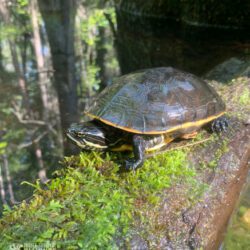
Apr 26, 2023
Species Spotlight! Eastern Chicken Turtle!

Apr 25, 2023
Species Spotlight! Vietnamese Three-striped Box…

Apr 22, 2023
Species Spotlight! Yellow-margined Box Turtle
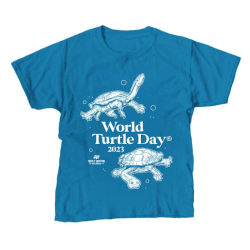
Apr 21, 2023
Celebrate turtles and tortoises with…

Mar 28, 2023
Cast Your Vote for Pancakes!

Mar 20, 2023